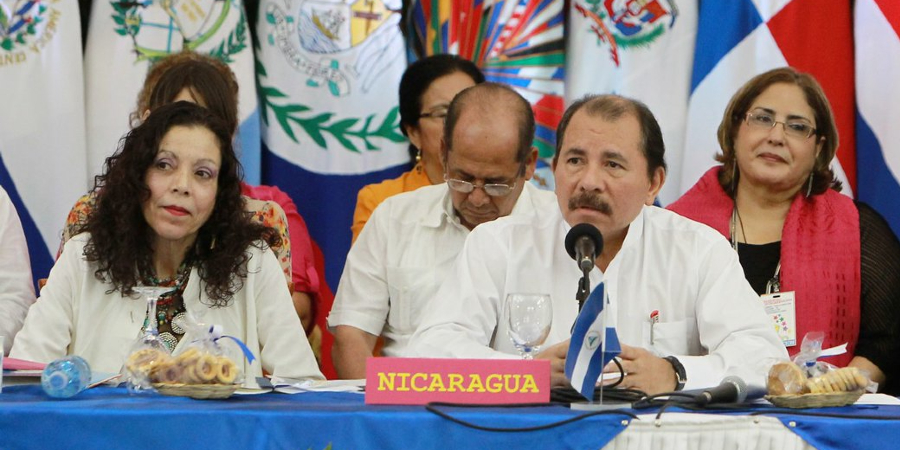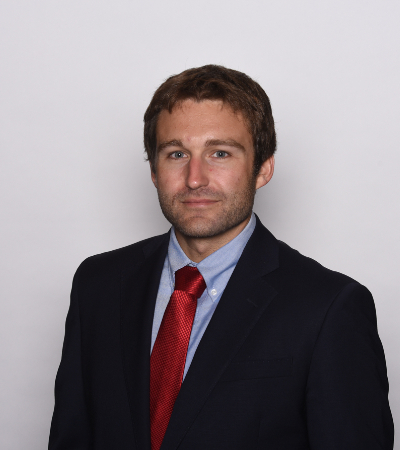Nicaragua’s Political Repression Will Continue Despite Prisoner Release
One thing about the releases is clear: Ortega and Murillo do not provide charity.

Published by The Lawfare Institute
in Cooperation With

Editor’s Note: Optimists hoped that the Feb. 11 prisoner release in Nicaragua signaled cracks in the dictatorial regime there, or at least some hope of reform. UC Santa Barbara’s Kai Thaler argues that any political opening in Nicaragua is unlikely and that the regime will remain repressive and personalistic—though it may prove brittle in the end.
Daniel Byman
***
On the morning of Feb. 11, Nicaragua released 222 political prisoners and put them on a flight to the United States in a deal arranged between the Nicaraguan and American governments. This unexpected turn is a humanitarian victory, with former prisoners now able to reunite with family abroad and receive proper medical care and support—after months or years of torture and deprivation. Despite the release, there are no signs that Nicaragua’s authoritarian executives, President Daniel Ortega and Vice President and First Lady Rosario Murillo, are any closer to significant political reforms or reducing repression.
Ortega has been president now since 2007, with Murillo, long considered the power behind the throne, installed as vice president in fraudulent elections in 2016. The pair survived mass nationwide protests in 2018 calling for their resignation and democratic elections. After a month of demonstrations, the government agreed to a Catholic Church-brokered national dialogue with civil society and opposition leaders in May 2018, but starting that July, Ortega and Murillo lethally reasserted control, with police and pro-government paramilitaries killing more than 300 people.
Ortega has described Murillo as “co-president,” and their family has swallowed up increasingly large portions of the country’s economic power and political posts. The 2021 elections were a sham, with no opposition allowed and Ortega and Murillo’s victory a foregone conclusion. Municipal elections in 2022 were used to install mayors from their party, the Sandinista National Liberation Front (FSLN), everywhere in Nicaragua.
The recently released political prisoners found themselves in Ortega and Murillo’s sights for daring to question the ruling couple’s power. Some were protest leaders in 2018, like student activist Lesther Alemán, who enraged Ortega at that spring’s national dialogue when he told the president that “[t]his is a table to negotiate your exit.” Some were targeted for protesting after 2018, as the government sought to strangle dissent. Those released also included journalists like Luis Galeano and Juan Lorenzo Holmann and civil society leaders like Tamara Dávila and Irving Larios. Others were critical former members of the ruling FSLN party. Dora María Téllez and Victor Hugo Tinoco were FSLN guerrilla leaders in the 1970s and served in the 1980s revolutionary government, but split off in the 1990s as Ortega, out of power, centralized the FSLN around himself.
Seven of those released—Cristiana Chamorro, Juan Sebastián Chamorro, Arturo Cruz, Medardo Mairena, Félix Maradiaga, Miguel Mora, and Noel Vidaurre—had been planning to run against Ortega in the 2021 elections until he imprisoned them. Repression eased enough in 2019 and 2020 that some government opponents who had fled abroad returned to Nicaragua, and the opposition hoped that the 2021 elections would give them a new chance to challenge the government—but those hopes were dashed with a new wave of repression.
Until the prisoner release, repression had been unrelenting. Since 2018, the Nicaraguan government has engaged in a campaign of canceling nongovernmental organizations’ legal status, shuttering more than 3,000 and strangling civil society. The government and its supporters have also subjected Catholic priests and laypeople to arrests and banned religious processions, seeking to silence the only remaining institution capable of questioning Ortega and Murillo within Nicaragua. Notable among the absentees on the flight to the United States was Bishop Rolando Álvarez. He refused to accept exile, angering Ortega, and was moved from house arrest to prison after telling the government, “Let the others go free, I will accept their punishments.” Along with Álvarez, 34 other political prisoners remain jailed.
Despite sanctions ratcheting up over the past few years, Ortega and Murillo had shown little willingness to compromise or engage with international critics beyond barbed attacks on “imperialism.” The upheaval of 2018 and then the coronavirus crisis prompted a recession, but since then the Nicaraguan economy has been stumbling forward, propped up by continued loans from the International Monetary Fund and Central American Bank for Economic Integration and by remittances from those who have fled abroad.
So why the sudden change in releasing the political prisoners? Knowing Ortega and Murillo’s true motivations is always difficult, but there are a few possibilities. First, it may have been a spontaneous move by an increasingly erratic government that has historically refused to release anyone. In a speech on the day of the release, Ortega claimed there had been no negotiations and that Murillo had come up with the idea, saying, “Why not tell the [U.S.] ambassador to take these terrorists?” But the move might not have been quite so spur of the moment—after all, Ortega had also proposed the idea in 2021. Given the U.S. track record of back-channel discussions with similar pariah states, like Cuba, it seems likely that diplomats had been pushing for political prisoners’ freedom—though Ortega and the U.S. government both say nothing was requested or given in exchange.
Second, Ortega and Murillo may be hoping this leads to sanctions relief. They have long attacked international sanctions, including trying to leverage the coronavirus pandemic for sanctions removal even while denying the virus’s seriousness. Recent sanctions escalations have squeezed the Ortega-Murillo family and their inner circle more than before, with hundreds of government officials and allies banned from traveling to the United States and targeted sanctions now affecting the lucrative gold and sugar industries. U.S. Secretary of State Antony Blinken said the prisoners’ release “opens the door to further dialogue” with the Nicaraguan government, and sanctions will be high on Ortega and Murillo’s agenda if new talks occur. At this juncture, though, there is little evidence that either tightening or loosening sanctions would lead to reduced repression or the restoration of democratic freedoms.
Third, Ortega and Murillo may have decided that holding on to the political prisoners was more trouble than it was worth. The death of an imprisoned former FSLN guerrilla hero, Hugo Torres, in February 2022 sparked outrage domestically and internationally. With dozens of prisoners elderly or in poor health after mistreatment and lack of medical care, there was a risk of further deaths in custody and further international pressure.
One thing about the releases is clear, though: Ortega and Murillo do not provide charity. As the 222 releasees were in transit, the FSLN-controlled National Assembly designated the former prisoners as traitors unable to hold public office in Nicaragua and passed a hasty constitutional reform to strip their citizenship. These moves were never discussed with the United States beforehand and are illegal under international law—though Ortega and Murillo routinely disregard U.N. and Inter-American Court for Human Rights procedures and orders, so they will be unconcerned.
The former prisoners’ forced deportation follows a recent pattern of Nicaragua revoking dual-nationals’ Nicaraguan citizenship and preventing government opponents from returning to the country, which has continued even since the prisoner release. On Feb. 15, a judge revoked the citizenship of 94 other opponents, many of them already in exile, and the government then began seizing their property.
The United States taking in the former prisoners also lets Ortega and Murillo stick to their long-standing narrative that the 2018 protests and subsequent opposition organizing were not the acts of Nicaraguans seeking democracy, but of “terrorists” and traitors who were supposedly part of a U.S.-sponsored coup plot. Their media echo chamber will reinforce these claims among FSLN supporters, while security forces’ and informants’ control around the country means new protests are highly unlikely. Even FSLN members who stuck around through the 2018 crackdown wound up in prison or are now in exile if they fell afoul of the regime. Opposing Ortega and Murillo now has a clear cost for Nicaraguans: You might never see your homeland again.
The prisoners’ release is not necessarily a sign of weakness for the Nicaraguan government. Ortega and Murillo may have decided releasing the prisoners would remove a focal point of domestic and international attention, while expelling their most prominent critics from the country. With the Biden administration seeking a reset with Latin America’s authoritarian governments and trying to reduce migration to the southern U.S. border, Ortega and Murillo might also be anticipating opportunities for a softening U.S. stance.
Nicaraguans have been arriving at the U.S. border in unprecedented numbers, after decades of migrating primarily to Costa Rica. While the Biden administration opened some new legal pathways for Nicaraguan migration by air in January, it is taking a harder stance against arrivals at the border. Improved economic conditions in Nicaragua or renewed hopes for political improvements could reduce the pressures to leave for some Nicaraguans, while Ortega and Murillo might also want to slow the population drain.
Conditions for freedom of expression, association, and assembly in Nicaragua, let alone free and fair elections, remain far away. The release of political prisoners is a cause for celebration, but if this is to lead to more positive changes, the international community must continue pressing the Ortega-Murillo government for concessions and supporting independent media and civil society groups in exile. Personalist dictatorships can be very durable—the Somoza family ruled Nicaragua for nearly half a century—but they can also be brittle. Nicaraguan pro-democracy actors and their international allies must keep searching for cracks within the regime.
The former political prisoners deserve time to recover, whether they remain in the United States, accept Spain's or Chile’s offers of citizenship, or go elsewhere. Yet in their shared traumatic experience and now their shared liberation, they show that Nicaraguans across the political spectrum suffer together due to the dictatorship and can experience moments of joy together. It took broad coalitions to topple the Somoza family dictatorship in 1979, to win the democratizing 1990 elections against the FSLN, and to take control of Nicaragua’s streets in April 2018. Unity has been hard to come by in the Nicaraguan opposition, but if the political prisoners’ release can help forge it and reinvigorate the fight for a democratic Nicaragua, that would be a victory, no matter what Ortega and Murillo intended.





